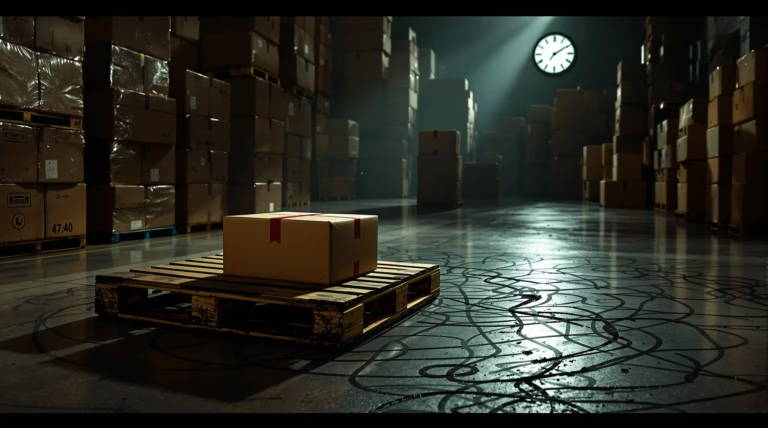Curious about what happens to your package once it enters the UPS system? Let’s explore the sophisticated journey your shipment takes from pickup to delivery, including the crucial processing stages that ensure its safe and timely arrival.
What is UPS Processing for Delivery?
UPS processing for delivery encompasses the systematic handling of packages within UPS facilities throughout their shipping journey. When your tracking shows “processing at UPS facility,” it indicates your package has entered the UPS logistics network and is undergoing essential preparation steps. This phase transforms a simple package drop-off into a meticulously managed delivery process.
During processing, packages undergo multiple operations while UPS’s advanced logistics management systems handle millions of parcels daily. The processing stage establishes the foundation for:
- Package scanning and verification
- Systematic sorting procedures
- Route optimization
- Real-time tracking updates
- Efficient delivery scheduling
Understanding the Basics of UPS Processing
The foundation of UPS processing centers on several integrated components. Upon facility entry, packages receive immediate scanning, creating a digital footprint that enables real-time tracking and internal logistics management.
During the sorting phase, packages are categorized based on:
- Final destination
- Service level requirements
- Delivery specifications
- Transportation mode needed
- Route optimization factors
Key Stages in the UPS Delivery Process
| Stage | Description |
|---|---|
| Acceptance & Verification | Initial tracking scan and shipping details confirmation |
| Primary Sorting | Geographic grouping and transportation method determination |
| Distribution Center Processing | Secondary sorting into specific delivery routes |
| Route Assignment | Organization of 100-200 stops per truck for 9-11 hour delivery routes |
| Final Delivery | Package delivery and final confirmation scan |
The Journey of a Package: From Pickup to Delivery
UPS manages over 24 million packages daily worldwide through a sophisticated logistics network. Each package follows a carefully orchestrated path with multiple checkpoints and transfers, ensuring safe and timely delivery while maintaining optimal efficiency.
Pickup and Initial Processing
The journey begins with package collection through scheduled pickup, UPS location drop-off, or regular route collection. The initial scan creates a digital record capturing:
- Package dimensions and weight
- Shipping information
- Delivery address validation
- Package condition documentation
- Entry timestamp into the UPS network
Transportation and Sorting
The transportation phase utilizes a hub-and-spoke system where packages move through regional sorting centers. Modern sorting facilities can process up to 416,000 packages per hour, with capabilities expanding to handle over 30 million packages during peak periods. Advanced technology ensures efficient movement through:
- Automated conveyor systems
- Computer-controlled diverters
- Label scanning technology
- Geographic zone sorting
- Route-specific organization
Final Delivery and Confirmation
The last phase of your package’s journey begins at the UPS facility nearest to its destination. Packages undergo a final sorting process as they’re organized onto delivery vehicles according to optimized route plans. Each morning between 8-9 AM, drivers arrive to load their trucks with packages arranged in precise delivery sequence for maximum efficiency.
- Daily driver delivery volume: 100-200 packages
- Computer-generated routes for minimal fuel usage
- Strategic package arrangement for delivery sequence
- Real-time GPS tracking capabilities
- Electronic signature collection system
At your address, the driver performs a final package scan using a handheld device that records delivery confirmation with timestamp and GPS coordinates. For signature-required deliveries, this information is collected electronically. If you’re unavailable, the driver follows your specified delivery preferences or standard UPS protocols for secure package placement. This final scan triggers delivery confirmation in UPS systems, allowing you to verify receipt through tracking updates. Throughout its journey, each package typically generates 19 tracking scans, ensuring comprehensive visibility from start to finish.
How to Track Your UPS Shipment
UPS tracking provides real-time visibility of your package’s journey from pickup to delivery. With a tracking number, you can monitor your shipment’s current location, estimated delivery date, and processing milestones. The system updates as your package moves through various checkpoints, with most shipments receiving 5-10 tracking scans during transit. This comprehensive tracking system serves both domestic and international shipments, keeping senders and recipients informed throughout the delivery process.
Using the UPS Tracking System
The UPS tracking platform offers multiple convenient access points for monitoring your shipments. The primary method involves using the ‘Track a Package’ feature on the UPS website – simply enter your 1Z-prefixed 18-digit tracking code to view instant status updates. The UPS Mobile App provides enhanced functionality with saved tracking numbers and push notifications.
- UPS My Choice features:
- View all incoming deliveries without tracking numbers
- Modify delivery instructions
- Set vacation holds
- Redirect to UPS Access Points
- Receive delivery alerts
Understanding Tracking Updates and Notifications
| Status Message | Meaning |
|---|---|
| Origin Scan | Package has entered the UPS system |
| In Transit | Moving between facilities |
| Out for Delivery | On delivery vehicle |
| Delivered | Final confirmation of receipt |
UPS offers customizable notifications through email, text message, or app alerts for key milestones or exceptions. The delivery window estimate becomes more precise as your package approaches its destination. For signature-required deliveries, you’ll receive notifications about delivery attempts and rescheduling options, creating a transparent shipping experience without constant tracking page checks.
Handling Lost or Damaged Packages
When packages are lost or damaged during processing, UPS follows established protocols to resolve these situations through a systematic claims process. For damaged items, the company requires specific documentation to process claims effectively.
- Required documentation for damage claims:
- Detailed documentation of damage
- Photos of affected packaging
- Proof of item value
- Original shipping documentation
- Description of package contents
| Package Status | UPS Response Protocol |
|---|---|
| Lost Package | Initiates tracking procedures using scan history and package imaging systems |
| Damaged Package | Conducts investigation to determine damage point and packaging compliance |
| Unrecovered Items | Processes reimbursement based on declared value and insurance coverage |
For lost packages, UPS employs advanced tracking procedures that utilize their comprehensive scanning history and sophisticated package imaging systems. These systems help identify misrouted items by referencing visual records captured during initial processing. While most missing packages are eventually located within the network, UPS provides reimbursement options for confirmed lost shipments based on declared value and insurance coverage.
Regular business shippers often manage claims processing in-house, though this can be a complex process requiring dedicated attention. For individual consumers, UPS customer service representatives handle the entire claims process, coordinating between sender and recipient to ensure fair and efficient resolution of shipping issues.





